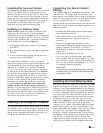
7
YY
YY
Y
English
L-2448B Installation
on the unit. Ensure that there are no leaks in the field
installed portion of the system. The water reservoir has
a float switch to ensure that the unit does not operate
without water supply.
Water Quality
No water which comes from municipalities is ‘pure’
water. Water from the water maker on board a vessel
will come as close as you will probably see. The
problem is that water contains suspended and dis-
solved solids. Pure water freezes first, leaving the
solids to increase in concentration in the unfrozen
water. Solids also bond to the evaporator wall during
freezing, forming scale. Eventually, built up scale will
shorten machine life. A filter should always be used,
preferably one approved by Dometic for use with ice
makers. The filter should be replaced at least twice
yearly, or more often if the machine is used often.
While filters will help clean the water, a yearly cleaning
of the evaporator barrel is required, see the Mainte-
nance section, under Evaporator Cleaning.
Use of Saltwater as the Evaporator
Saltwater use in the evaporator to make ice is not
approved by Dometic, even though the machine can
freezer salt water. Salt water is very corrosive in itself,
plus it contains many more dissolved and suspended
solids than freshwater. If you wish to have brine
solution for your catch, we suggest sprinkling some
salt over the ice in the catch box. USE OF SALT-
WATER IN ANY DOMETIC ICE MAKER WILL VOID THE
WARRANTY!
Installing the Seawater Cooling
System
The following installation instructions apply to ice
maker units as well as general air conditioning units.
Importance of a Self-Draining System
A poorly plumbed seawater system is one of the most
common installation problems on marine refrigeration
and air conditioning. When water flow is lost, not only
with the ice maker cease to produce ice, but the pump
could be damaged from running with no water flow.
When using a centrifugal seawater pump, it is impera-
tive that the seawater piping be routed continually
uphill from the through-hull to the condenser, then
smoothly up or down to the overboard discharge,
without any dips of loops, and with only one high point
in the system. This is called self-draining because all
the water will drain out of the piping if the boat were
taken out of the water.
Whenever air gets into the system, which can happen
in heavy seas or a sharp turn, it can become trapped
in the pump. Because centrifugal pumps cannot pump
air, water flow is lost.
A self-draining system will allow air in the piping to
rise naturally through the pump and then be expelled.
It will also make winterizing the system much easier.
Figure 7 shows a properly plumbed system and some
common mistakes.
Through-Hull Inlet Fitting
A separate through-hull fitting must be installed for
each seawater pump. Do not attempt to draw water
from an engine, generator, or other through-hull fitting.
A scoop-type through hull should be installed facing
forward, as far below the water line and as close to the
keel as possible.
Drill a properly sized hole for the through-hull fitting.
Bed the scoop with marine sealant designed for
underwater use, and tighten the nut onto the through-
hull to secure it.
Seacock
A full-flow seacock should be installed directly onto the
through-hull fitting. Use Teflon tape or equivalent to
seal the threads. The seacock must be accessible and
easy to close in case of emergency, of to clean the
strainer.
Strainer
A seawater strainer must be installed between the
seacock and the pump, and should be situated to
provide easy access for cleaning. The strainer must be
located vertically above the seacock and below the
pump so any air that gets into the strainer can get out.
Make sure the water flow through the strainer is in the
correct direction. Some strainers have an arrow that
shows correct flow direction.
Mount the strainer to a bulkhead so it is properly
supported before connecting hoses. Use Teflon tape or
equivalent on pipe threads.


















